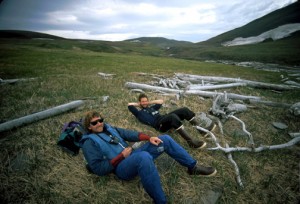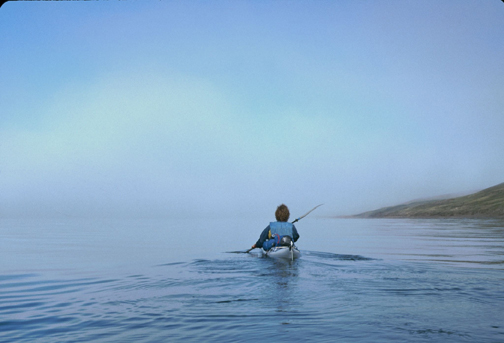Alaska landscape loses a body, gains a spirit
October 7, 2010
907-474-7468
10/7/10
Keith Echelmeyer has died at age 56. The glaciologist, pilot, mountaineer and fighter for life passed away last Saturday, with his incomparable wife Susan Campbell by his side and chickadees at the feeder just outside his window.

His death from a brain tumor was not a surprise, but his enduring it for eight years was. Keith did some impressive science in his two decades at the Geophysical Institute at the University of Alaska Fairbanks. He figured out baffling complexities of ice streams in Antarctica, worked on the fastest flowing glacier in the world in Greenland years before it became big news, and outfitted his single-engine Piper PA-12 with a laser rangefinding system that allowed his team to measure staggering ice loss on Alaska glaciers.
In 2002, after Keith flew his plane from Fairbanks to Yakutat for a conference he helped organize, he suffered violent seizures and was medevaced to Providence Alaska Medical Center in Anchorage. There, he learned he had a brain tumor. Keith, with the help of Susan and a team of doctors from the Fairbanks area and Duke University, fought that tumor for eight years. In that time, he still managed to do things he should not have been able to do, such as walk, ski, and go on two-week backpacking trips in his beloved Brooks Range.
Susan was with him for the small victories and the crushing setbacks. In the end, she turned their home into a place of light, with a constant stream of friends and an uplifting air of gratitude. People often left their home with the unexpected sensation of feeling happy.
Here are some reflections from a small sample of Keith's friends, some who were also his colleagues: Carl Benson, professor emeritus and glaciologist at the Geophysical Institute: "He was a very good pilot. He was good at glaciology. He was very good at interpreting geologic features on the face of the Earth. He was a very good writer, one of the people you could count on to edit things, and he was incredibly strong. His physical strength and mental ability all came together to make quite a guy."
Roman Motyka, GI glaciologist: "He had this childlike curiosity about everything. He had no hesitation at all about asking questions. (His sickness) could have crushed him, but instead he went in the other direction. Once he accepted it, he opened up his heart. I'm working in Greenland, and I keep going back to his papers, what he did in 1985 and 1986. Keith's going to keep popping up in my life."
Will Harrison, GI professor emeritus and glaciologist: "I used to kid him about how many grad. students' careers he destroyed. Because your normal grad. student thought he could take Keith as a model and succeed. But not many people can do what he did (the mountaineering trips every weekend, flying his airplane) and succeed professionally. He had two lives, the adventure life and the professional one, and he was able to sustain both, which is saying a lot about human energy and capability."
Geologist and pilot Richard Flanders: "He's done walking trips in the Brooks Range most people would write books about. He never believed in writing articles. He did it because he liked to do it. He was arrogant to some degree, but mostly he was impatient with people who didn't think they could do something. He just didn't think he had any limits. He was a driven person, and (his sickness) was another mountain to climb. He wouldn't sit back and let it take him. Just last spring he split all the wood I put in his driveway."
Geologist and mountaineer Jeff Benowitz: "He climbed iconic peaks in all of the (mountain) ranges. The Cassin (Ridge, on Denali), the west face of Deborah, Doonerak, and he climbed peaks nobody ever heard of and he never felt the need to tell anybody about it."
Chris Larsen, GI glaciologist: "He would always do surveying (turning metal knobs on a theodolite) barehanded in the wind. Everyone writing notes next to him would freeze their hands. Somehow, he could just say 'My hands aren't going to get cold.' Luke Skywalker had the Force. Keith had that. Don't worry about how it's getting done. Just do it. Keith was amazingly frugal (with projects such as mounting a laser-altimetry unit on his own aircraft to determine glacier shrinkage). He did a real service to science by keeping things cheap. He had that mountaineering mentality: efficient, small and fast."
Anthony Arendt, GI glaciologist: "He was really pioneering new stuff. GPS was in its infancy but he still made it work (in the laser-altimetry program). That unique combination of his science skills and his flying skills was really valuable. He had this fearlessness. Even though you don¹t know how to do something, you go out and figure it out. So many people with that powerful of a mind, all they do are academics. But for Keith, it was equally important to get outside and explore the wilderness."
John Carlson, principal of the Watershed School in Fairbanks and Keith's partner on an Alaska Mountain Wilderness Classic Ski Race from Nabesna to McCarthy: "He had this incredible awareness of the lay of the land. He¹d just glance at the topo. map and find the route. We never veered out of our way. I had just come off all that ultra (marathon) running and thought I was a stud, and he just buried me, day after day. He was just this dot up ahead on the landscape."
Martin Truffer, GI glaciologist: "He'd be in the office doing high-level science and then he goes out and does the first winter ascent of Doonerak (a mountain in the Brooks Range). He just managed to do everything. He had a connection to wild places that not a lot of people have. He really needed to be out there. The way he dealt with getting sick was that same character, the one that perseveres against reason. He mentally never gave up. He really fought this to the bitter end. But the graceful thing about (his death) was not to fight with every technological means available. That's the most inspiring thing, even when he couldn't talk, he showed his appreciation of people, maybe like never before. A lot of people lead their lives as different people because of Keith, and that's something." (Truffer took up flying soon after Keith became ill). "There was nothing average about Keith, ever. Even his singing and handwriting were exceptionally bad."
Jon Miller, Keith's climbing partner: "(On the approach to the first winter ascent of Mount Doonerak) one of our skis hit a freshly gnawed ram skull, and then we saw wolves, which were sort of a totem animal for Keith. Then 200 ptarmigan sailed away through this rosy light. He loved that stuff as much as a well-climbed pitch. As remarkable as (the time was before Keith was sick), the latter part of his life eclipses it for strength, endurance, and generosity. When he got sick, he started patching that hole (his strong personality traits that sometimes made him hard on others). He developed a generosity of spirit. He really brought people he had alienated back to him. The illness was tragic, but what (Keith and Susan) have done with it was very beautiful and inspiring. It wouldn't have been that way if he hadn't had that incredible strength, and those weaknesses too. Susan is every bit as strong as Keith is. He had so much taken away from him, and he continued to powerfully, cheerfully persevere. He's an incredible role model for all the adversity we¹re going to face in life. Both he and Susan gave us a road map."

This column is provided as a public service by the Geophysical Institute,
University of Alaska Fairbanks, in cooperation with the UAF research
community. Ned Rozell is a science writer at the institute.


